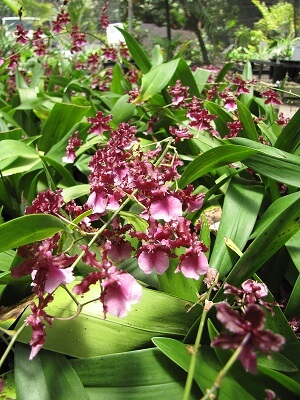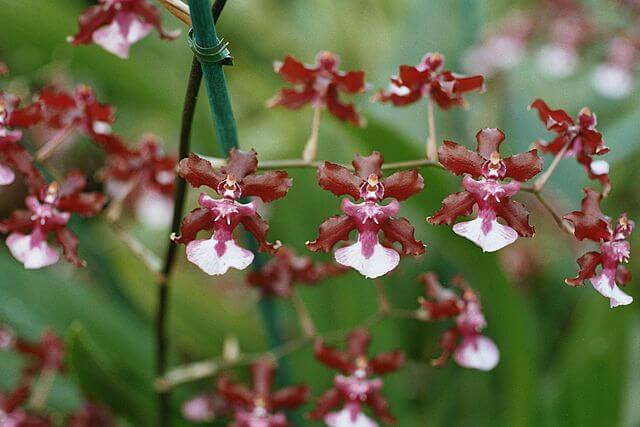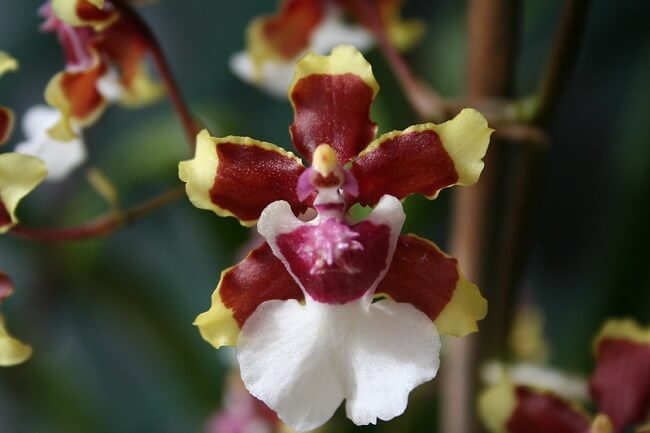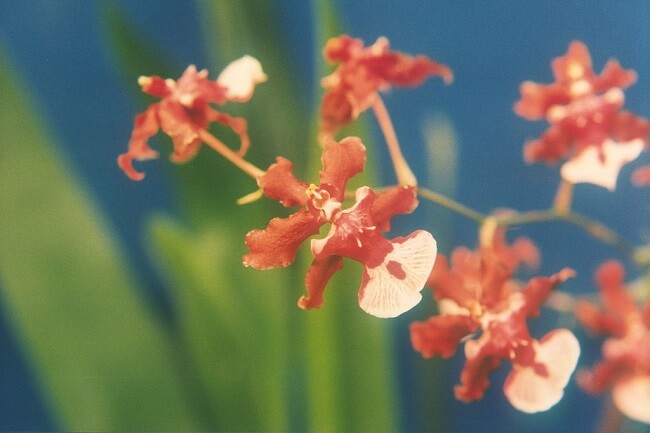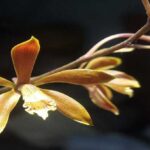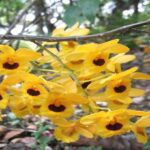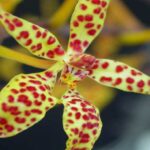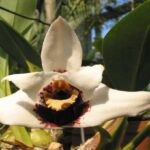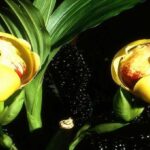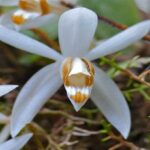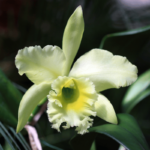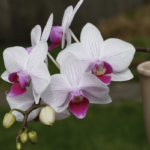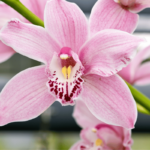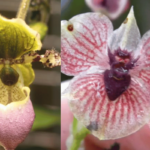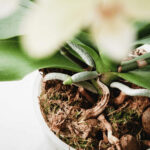The Chocolate Orchid or Oncidium sharry baby is an attractive option for any orchid enthusiast.
Normally, before choosing an orchid, we consider several factors.
Among these factors, some of the most common ones are:
- Ease of cultivation
- Beauty of the flowers
- Size of the plant
- And several others.
And the chocolate orchid became famous because:
- It is very easy to cultivate
- It has very beautiful flowers
- It does not take up much space in people’s homes
But these are not its main characteristics.
The Oncidium sharry baby became famous for its flowers having a scent very similar to chocolate.
To learn more about this incredible plant, keep reading this article.
History
Contrary to what many think, the Oncidium sharry baby is not a natural orchid.
That is, it cannot be found in nature, it was artificially created in laboratories in 1983 by Dorothy A. O’Flahert.
See in the image below the crosses that were necessary to create this species.
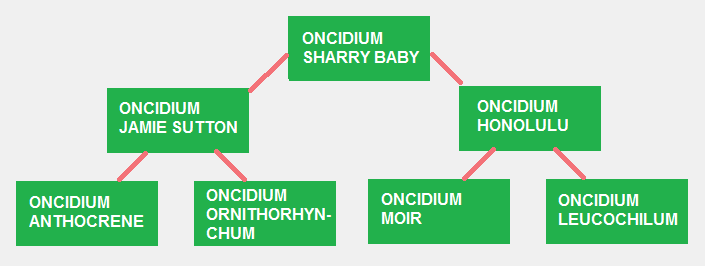
Although it is relatively new, this species has already won the hearts of many growers.
Today it is one of the highlights of the Oncidium genus, and practically anyone can have it in their home.
Characteristics
There are several interesting characteristics that we can talk about the chocolate orchid, but I will try to focus only on the main ones for you.
Chocolate orchid is the popular name for Oncidium sharry baby, which also has several varieties.
- Sweet Fragrance (the most famous and with the strongest chocolate smell)
- Ruby Doll
- Baby Tricolor
Don’t know what varieties are? Then check out the article orchid species.
In addition, this is an epiphytic orchid and in some places is also known as Ballerina Orchid.
And, going into slightly more technical details, you will notice that this plant has more vigorous pseudobulbs and larger leaves compared to the size of the flowers.
Oncidium Sharry Baby with Spots on the Leaves
We have already discussed the subject of spots on orchid leaves in a previous article, but in the case of Oncidium Sharry Baby, this is a special case.
Brazilian orchid species usually have some black or brown spots on the leaves.
These spots are very similar to infections or some other type of problem in orchids, but in the case of the chocolate orchid, they do not affect its health at all.
It is not known for sure what can cause them.
There are some theories such as:
- Virus
- Bacteria
- Excess light
- Allergy to the climate
These spots will only affect the appearance of your plant.
So if your orchid of this species started developing some black spots on the leaves after some time, you don’t need to be too alarmed.
Chocolate Orchid Flowers
Finally, let’s talk a little more about the main characteristic of this plant, its flowers.
See below the main curiosities about its flowering:
- Can occur at any time of the year
- The flowers usually last from 30 to 45 days
- Its flowers are usually 4cm (1,57 inch) in diameter (considered a mini orchid)
- Can bloom up to 2 times a year
- The flowers can be various colors such as: white, brown, yellow, and even pink.
- The number of flowers generated depends on various factors such as: brightness, fertilization, how many years the plant has, number of pseudobulbs, etc.
- The flowers emit a fragrance of chocolate or vanilla, with this smell being stronger in some varieties.
There are so many surprises that it is hard not to want to grow this plant.
Cultivation
If you have made it this far and have already decided to cultivate this orchid, I have several good news for you.
- It is cheap
- It is a hybrid (Hybrids are usually made to be more resistant)
- It is easy to cultivate.
Even beginners will be able to cultivate it, but to ensure you don’t make any mistakes, below I have listed some tips:
Where to Plant It
Being an epiphytic orchid (living on trees), it cannot be planted in the ground, but there are several other options:
- Hung on trees and trunks
- Plastic or terracotta pots
- Cache pots
In the case of trees, choose one that protects your orchid from direct sunlight.
In pots or cache pots, make sure they are not too large or too small for your orchid, ideally leaving space for the plant to grow.
Remember: do not leave water saucers under your orchid pots, this can cause root diseases.
How to Water
Watering is another extremely simple factor.
The chocolate orchid should be watered just before its potting mix dries, but when watering it, be very careful not to soak your plant.
Some people recommend watering every 5 days, but this is not a rule.
The right time to water your orchid depends on various factors:
- Humidity
- Temperature
- What potting mixes it uses
- Ventilation
Therefore, it is correct that you sink a pencil or your finger into the potting mix to see if it is almost dry.
If it is, water the plant, if it is not, wait another day.
Lighting
When learning to grow orchids, there is a very useful tip that helps us identify the ideal lighting for a particular plant.
Basically, we will look more closely at its leaves.
- If they are yellowish, the plant is receiving excessive sunlight
- If they are a darker green, the plant is receiving little sunlight
Therefore, use this tip and experiment with your Oncidium to find out what is ideal.
One tip is for you to do the following:
Leave it exposed to the sun during the period when the sun is cooler (before 9:00 a.m. and after 5:00 p.m.), in the other period it should be in the shade.
Temperature and Humidity
This is an orchid that does not like high temperatures very much, with a moderate or cooler environment being ideal.
As for humidity, it can vary depending on the location where you plant your Sharry Baby.
- If it is on trees, try to provide higher humidity than 60%
- If it is in pots, humidity can be a little lower, but ideally it should also be close to 60%.
Some tips:
- Make sure the nighttime temperature is at least 2°C to 4°C (35,6°F to 39,2°F) cooler than the daytime temperature.
- Place your plant near water sources or find ways to increase the humidity in the environment.
- Use weather forecast websites to find out the humidity in your city.
Potting Mixes
Potting mixes are one of the most important parts of cultivation.
With them, you can meet some needs that your plant normally wouldn’t be able to.
For example, maintaining higher humidity or fixing it in the pot.
In the case of the chocolate orchid, it is ideal that you provide a potting mix that offers good drainage.
Some great options are:
- Pine bark
- Charcoal
- Sphagnum (in small quantities)
Avoid using coconut fiber, as it retains a lot of water and has some problems that can be harmful to your orchid, such as tannins.
Repotting
This is an orchid that does not like to be repotted very much, so only do it if it is really necessary.
Usually repot is done for the following reasons:
- Plant too big for the current pot
- Potting mix too old
- Fighting root diseases
Replant during your orchid’s growth period.
Chocolate Orchid in Decoration
Now that you have learned how to cultivate your chocolate orchid, did you know that you can use it to decorate your home?
Below are some very common places where this plant is seen:
- Flower bouquets
- Gardens
- Vertical gardens
- Bridal hairstyles
- Several other places.
The Sharry Baby is a plant that can decorate various places, adding its beauty and fragrance.
Other Scented Oncidium
In addition to the chocolate orchid, oncidiums have several species that, when flowering, produce curious perfumes.
That’s why below are some more plants of this genus and their respective scents:
- Oncidium pumilum: honey
- Oncidium ornithorhynchum: bleach, egg, medicine, etc. Some people smell different scents in this plant.
- Gomesas Crispa (a relative of Oncidium): a citrus scent, resembling lemon.
- Oncidium Twinkle: chocolate
Conclusion
Who would have thought it would be possible to have an orchid with such a familiar scent?
Today, the Oncidium Sharry Baby shows us how science has evolved and how nature is amazing, to the point of allowing the creation of plants like this.
Absolutely incredible!
If you think so too, it’s your turn to participate. Share this article on your social media by clicking on the icons below.

